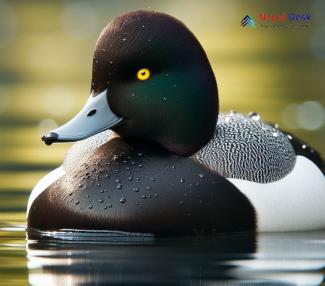The Greater Scaup (Aythya marila), a fascinating species belonging to the diving duck family, has always captured the attention of birdwatchers and nature enthusiasts alike. Often found inhabiting the cold Arctic regions during the breeding season, these beautiful birds typically inhabit freshwater lakes, rivers, and coastal waters outside the breeding period. The greater scaup was formally described by Carl Linnaeus in 1761 under the binomial name Anas marila but is now placed in the genus Aythya that was introduced for the greater scaup by the German zoologist Friedrich Boie in 1822. At least two subspecies of Greater scaup are recognized namely A. m. marila and A. m. nearctica.
In this article, we will unravel some interesting details about the Greater Scaup while exploring their mysterious presence in Nepal.
A Closer Look at the Greater Scaup
Characterized by their rounded heads and bluish-gray bills, male Greater Scaups are easy to identify by their black and white plumage. The females, on the other hand, exhibit a more uniform brown color with subtle hints of white around their heads.
When feeding, these diving ducks showcase an impressive ability to dive great depths underwater, searching for mollusks, crustaceans, and aquatic plants that form an essential part of their diet. While they lack the overall agility of their dabbler counterparts (like Mallards), they compensate for it with powerful legs and webbed feet that propel them beneath the surface.
A Rare Sight: Greater Scaup in Nepal
The presence of Greater Scaup in Nepal has intrigued bird enthusiasts due to its rarity in reported sightings. Situated between the eastern and southern migrations routes, Nepal serves as a temporary respite for many migratory birds as they embark on their journey through Asia.
The first documented sighting of a Greater Scaup in Nepal took place in 2002 at Gokyo Lake - one of Nepal's highest-altitude freshwater lakes located amidst the beautiful mountain landscape. Since then, there have been sporadic reports of these special ducks being sighted at wetland areas such as Jagadishpur Reservoir and Koshi Tappu Wildlife Reserve. These sporadic encounters make the Greater Scaup an enticing addition to the list of over 900 bird species found in Nepal.
Conservation Efforts and Future Prospects
Although the International Union for Conservation of Nature (IUCN) categorizes the Greater Scaup as a species of "Least Concern," recent population trends have raised concerns among conservationists. Shrinking habitats, pollution, and hunting pressures have contributed to a slow but steady decline in their numbers. As such, efforts are being made globally to protect and conserve these magnificent birds.
For Nepal, the presence of Greater Scaups highlights the country's rich biodiversity and the importance of preserving its natural habitats. By enhancing conservation measures within key wetland reserves, migratory species like the Greater Scaup can continue to grace these ecosystems with their fleeting visits.
In summary, the enigmatic Greater Scaup presents birdwatchers in Nepal with an opportunity to witness these Arctic visitors amidst the vast mosaic of avian species present in this naturally diverse country. As awareness and conservation efforts increase, it is our hope that these unique birds will continue to find refuge among Nepal's unspoiled landscapes for future generations to admire and appreciate.




